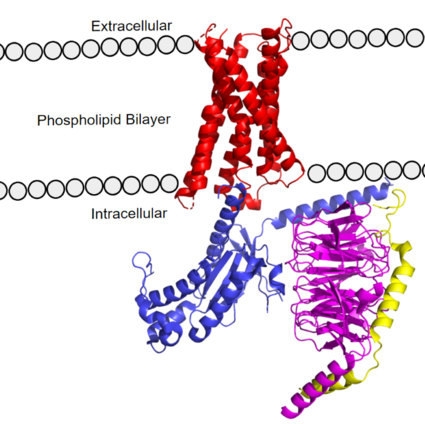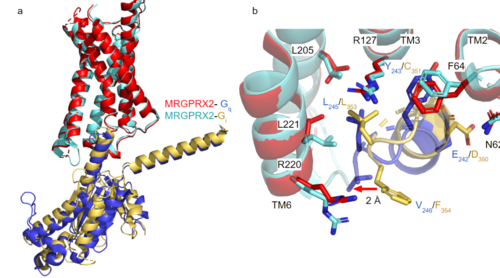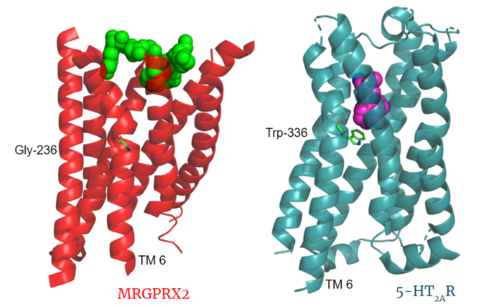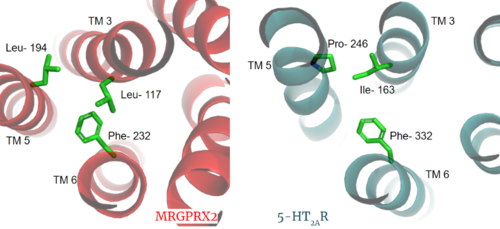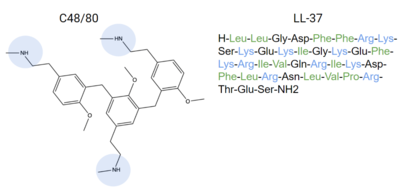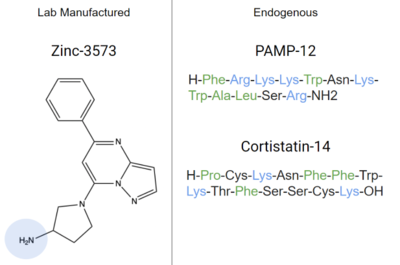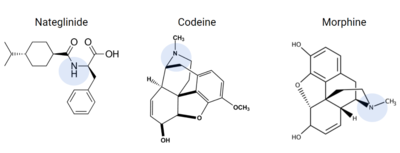Sandbox Reserved 1700
From Proteopedia
(Difference between revisions)
| (8 intermediate revisions not shown.) | |||
| Line 4: | Line 4: | ||
MRGPRX2 is a certain type of [https://proteopedia.org/wiki/index.php/G_protein-coupled_receptor GPCR] that is located in the cellular membranes of mast cells. | MRGPRX2 is a certain type of [https://proteopedia.org/wiki/index.php/G_protein-coupled_receptor GPCR] that is located in the cellular membranes of mast cells. | ||
| - | [[Image:Main_figure.png|425px|right|thumb|'''Figure 1.''' MRGPRX2 as it sits within the cellular membrane. Phospholipid bilayer is represented by grey dots, with labeled cellular locations]] | + | [[Image:Main_figure.png|425px|right|thumb|'''Figure 1.''' MRGPRX2 as it sits within the cellular membrane. Phospholipid bilayer is represented by grey dots, with labeled cellular locations. PDB: 7s8l]] |
== Background == | == Background == | ||
| - | + | [https://en.wikipedia.org/wiki/G_protein-coupled_receptor GCPR]’s or G-Protein Coupled Receptors are a large family of protein receptors that promote cellular signaling and [https://en.wikipedia.org/wiki/Signal_transduction signal transduction]<ref name= “Tuteja”>PMID: 19826234</ref>. GPCRs transmit extracellular signals to intracellular messages. Many essential pathways utilize GPCRs, including human vision by the GPCR [https://proteopedia.org/wiki/index.php/Rhodopsin Rhodopsin], and the adrenaline fight-or-flight response by the [https://proteopedia.org/wiki/index.php/Beta2_adrenergic_receptor-Gs_protein_complex_updated β2-adrenoceptor GPCR]. Understanding GPCR’s and how they produce their desired intracellular signal is essential to studying essential cellular pathways, especially in their diseased states. GCPRs are common drug targets, with 475 drugs acting on over 100 GPCRs. An additional 300 drugs are in clinical trial stages, and 20% of those drugs are targeting novel GPCRs <ref name="Hauser">PMID:29075003</ref>. Because of the clinical relevance of GPCRs, new structures provide new avenues for drug development to both treat disease or modulate the harmful side effects. | |
| - | Some cells in the human body that express the MRGPRX2 receptor include [https://en.wikipedia.org/wiki/Mast_cell mast cells] in the skin, intestines, and trachea <ref name="Porebski">PMID:30619367</ref><ref name="Dondalska">PMID: 33101278</ref>. Mast cells are immune cells responsible for triggering inflammatory responses | + | Some cells in the human body that express the MRGPRX2 receptor include [https://en.wikipedia.org/wiki/Mast_cell mast cells] in the skin, intestines, and trachea <ref name="Porebski">PMID:30619367</ref><ref name="Dondalska">PMID: 33101278</ref>. Mast cells are immune cells responsible for triggering [https://en.wikipedia.org/wiki/Inflammation inflammatory] responses. Mast cells are densely packed with [https://en.wikipedia.org/wiki/Granule_(cell_biology) granules] containing inflammatory chemicals, such as [https://en.wikipedia.org/wiki/Histamine histamine] and [https://en.wikipedia.org/wiki/Heparin heparin]<ref name= "Dondalska" />. Mast cells can be activated by either [https://en.wikipedia.org/wiki/Antibody antibodies] from the immune response or upon [https://en.wikipedia.org/wiki/Ligand ligands] binding to MRGPRX2 receptors on their surface<ref name="McNeil">PMID: 25517090</ref>. Upon activation, mast cells will release histamine-containing granules which can trigger a larger inflammatory response <ref name= "Dondalska" /><ref name="McNeil" />. These responses induce common allergic reaction or [https://en.wikipedia.org/wiki/Anaphylaxis anaphylaxis] symptoms, such as cutaneous itching sensations or airway constriction<ref name= "Cao" /><ref name= "Yang" /><ref name="McNeil">PMID: 25517090</ref>. |
| - | Ligands that bind to MRGPRX2 in the natural environment to produce an allergic response include [https://en.wikipedia.org/wiki/Exogeny#Biology_and_Medicine exogenous] molecules | + | Ligands that bind to MRGPRX2 in the natural environment to produce an allergic response include [https://en.wikipedia.org/wiki/Exogeny#Biology_and_Medicine exogenous] molecules, some being contents of insect venom, molecules like [https://www.ebi.ac.uk/chebi/searchId.do?chebiId=CHEBI:75295 Compound 48/80 (C48/80)], or other polycationic molecules<ref name= "Dondalska">PMID: 33101278</ref><ref name= "Porebski" />. They can also respond to [https://en.wikipedia.org/wiki/Endogeny_(biology) endogenous] signaling molecules involved in inflammation pathways such as [https://en.wikipedia.org/wiki/Cytokine cytokines], [https://en.wikipedia.org/wiki/Anaphylatoxin anaphylatoxins], or [https://en.wikipedia.org/wiki/Neuropeptide#Receptor_targets neuropeptides]<ref name= "Porebski" />. Many pseudo-allergic drug reactions have been tied to overactivity of MRGPRX2 receptors on mast cells<ref name="McNeil">PMID: 25517090</ref>, so research into receptor-ligand interactions of the MRGPRX2 receptor has the potential to mediate many adverse itching and allergic reaction side effects seen in drugs today<ref name= "McNeil">PMID: 25517090</ref>. |
GPCRs are categorized into 6 different classes based on shared sequences and functions. MRGPRX2 is categorized into the [https://proteopedia.org/wiki/index.php/GPCR#Family_A_of_GPCRs Class A] receptor family. However, itch receptors like MGPRX2 have unique structural features from most class A receptors <ref name="Cao">PMID: 34789874</ref><ref name="Yang">PMID: 34789875</ref>. These unique structural features, as seen in '''Class A Family Differences''', cause conformational changes throughout the protein that impact what ligands bind to the receptor<ref name= "Yang" />. | GPCRs are categorized into 6 different classes based on shared sequences and functions. MRGPRX2 is categorized into the [https://proteopedia.org/wiki/index.php/GPCR#Family_A_of_GPCRs Class A] receptor family. However, itch receptors like MGPRX2 have unique structural features from most class A receptors <ref name="Cao">PMID: 34789874</ref><ref name="Yang">PMID: 34789875</ref>. These unique structural features, as seen in '''Class A Family Differences''', cause conformational changes throughout the protein that impact what ligands bind to the receptor<ref name= "Yang" />. | ||
| Line 20: | Line 20: | ||
=== Transmembrane Domain === | === Transmembrane Domain === | ||
The [https://en.wikipedia.org/wiki/Transmembrane_domain#:~:text=A%20transmembrane%20domain%20(TMD)%20is,can%20adopt%20a%20different%20conformation. transmembrane domain] spans the cell membrane ('''Figure 1''') and it consists of <scene name='90/904305/Transmembrane_protein_c_and_l/2'>seven transmembrane α-helices</scene> and <scene name='90/904305/Ecl_and_icl/3'>6 loops</scene> (three extracellular loops, and three intracellular loops). The transmembrane helices are numbered 1-7 and contain special conserved motifs that are shared across other A family receptors. These motifs are expanded upon later, as they heavily contribute to the structure and therefore function of the transmembrane domain as a whole. | The [https://en.wikipedia.org/wiki/Transmembrane_domain#:~:text=A%20transmembrane%20domain%20(TMD)%20is,can%20adopt%20a%20different%20conformation. transmembrane domain] spans the cell membrane ('''Figure 1''') and it consists of <scene name='90/904305/Transmembrane_protein_c_and_l/2'>seven transmembrane α-helices</scene> and <scene name='90/904305/Ecl_and_icl/3'>6 loops</scene> (three extracellular loops, and three intracellular loops). The transmembrane helices are numbered 1-7 and contain special conserved motifs that are shared across other A family receptors. These motifs are expanded upon later, as they heavily contribute to the structure and therefore function of the transmembrane domain as a whole. | ||
| - | The extracellular region of the 7 transmembrane domain forms a single [https://en.wikipedia.org/wiki/Binding_site binding pocket] with <scene name='90/904305/Subpockets_1_and_2/4'>two sub-pockets</scene>. Sub-pocket 1 is negatively charged due to negatively charged <scene name='90/904305/Subpockets_1_and_2_d_and_e/2'>aspartate and glutamate</scene> residues (Asp-184 and Glu-164), while sub-pocket 2 contains hydrophobic amino acids which contribute to hydrophobic interactions between the ligand and protein. | + | The extracellular region of the 7 transmembrane domain forms a single [https://en.wikipedia.org/wiki/Binding_site binding pocket] with <scene name='90/904305/Subpockets_1_and_2/4'>two sub-pockets</scene>. Sub-pocket 1 is negatively charged due to negatively charged <scene name='90/904305/Subpockets_1_and_2_d_and_e/2'>aspartate and glutamate</scene> residues (Asp-184 and Glu-164), while sub-pocket 2 contains hydrophobic amino acids which contribute to hydrophobic interactions between the ligand and protein. The intracellular region ('''Figure 1''') is what connects the transmembrane helices with the G-protein. |
| - | The intracellular region ('''Figure 1''') is what connects the transmembrane helices with the G-protein. | + | |
| + | This GPCR has been modeled both as MRGPRX2 and MRGPRX4<ref name="Cao">PMID: 34789874</ref><ref name="Yang">PMID: 34789875</ref>, though much of this page focusses on MRGPRX2. X4 is found to mediate cholestatic itch compared to X2's regulation of mast cell degranulation and hypersensitivity itch-reactions<ref name="Cao">PMID: 34789874</ref>. X4 and X2 demonstrate nearly the same structural differences compared to that of other class A GPCRs. Interestingly, X4 can interact with negatively charged bile acids and is insensitive to the common X2 cationic agonists discussed later ('''Figure 7'''). | ||
=== G-Protein === | === G-Protein === | ||
[https://proteopedia.org/wiki/index.php/G_protein GTP-binding proteins], also known as G-proteins, are heterotrimeric complexes consisting of <scene name=''90/904305/Structure_overview_alpha/2'>alpha</scene>, <scene name='90/904305/Structure_overview_beta/2'>beta</scene>, and <scene name='90/904305/Structure_overview_gamma/2'>gamma</scene> subunits that interact with the intracellular transmembrane region at an <scene name='90/904306/Interface_2/1'>interface</scene> ( '''Figure 2b'''). G-proteins are responsible for [https://en.wikipedia.org/wiki/Signal_transduction transmitting] extracellular signals into the cell upon activation. Activation leads to a substitution of GDP with GTP within the alpha subunit, causing the alpha subunit to disassociate from the beta and gamma subunits to initiate an intracellular signaling cascade. There are different families of G-alpha subunits, Gαi, Gαs, Gα12/13, and Gαq <ref name="Kamato">PMID: 26664886</ref>. MRGPRX2 binds to both Gαi and Gαq subunits with nearly identical structures despite slightly different amino acids present ( '''Figure 2a''') <ref name= "Cao" /> <ref name= "Yang" />. Throughout this page, MGPRX2 is always shown with Gq. The major difference between the Gq and Gi bound structures comes from one amino acid difference (valine on Gq versus phenylalanine on Gi) that pushes the Gi subunit 2Å away from the arginine residue on helix 6 of the transmembrane protein. | [https://proteopedia.org/wiki/index.php/G_protein GTP-binding proteins], also known as G-proteins, are heterotrimeric complexes consisting of <scene name=''90/904305/Structure_overview_alpha/2'>alpha</scene>, <scene name='90/904305/Structure_overview_beta/2'>beta</scene>, and <scene name='90/904305/Structure_overview_gamma/2'>gamma</scene> subunits that interact with the intracellular transmembrane region at an <scene name='90/904306/Interface_2/1'>interface</scene> ( '''Figure 2b'''). G-proteins are responsible for [https://en.wikipedia.org/wiki/Signal_transduction transmitting] extracellular signals into the cell upon activation. Activation leads to a substitution of GDP with GTP within the alpha subunit, causing the alpha subunit to disassociate from the beta and gamma subunits to initiate an intracellular signaling cascade. There are different families of G-alpha subunits, Gαi, Gαs, Gα12/13, and Gαq <ref name="Kamato">PMID: 26664886</ref>. MRGPRX2 binds to both Gαi and Gαq subunits with nearly identical structures despite slightly different amino acids present ( '''Figure 2a''') <ref name= "Cao" /> <ref name= "Yang" />. Throughout this page, MGPRX2 is always shown with Gq. The major difference between the Gq and Gi bound structures comes from one amino acid difference (valine on Gq versus phenylalanine on Gi) that pushes the Gi subunit 2Å away from the arginine residue on helix 6 of the transmembrane protein. | ||
| - | [[Image:Gq and gi overlay.png|500px|center|thumb|'''Figure 2a.''' Overlay of MGPRX2-Gq (red-dark blue) and MGPRX2-Gi (cyan-yellow). '''Figure 2b.''' Important residues involved in the interface between MGPRX2 and Gq/ Gi subunits. Arrow pointing to the major difference between the interfaces, which comes from the final C-terminus residue on the G-alpha subunit. In Gq, there is a valine while in Gi, there is a phenylalanine. This pushes the Gi subunit 2Å away from the arginine residue on helix 6 of the transmembrane protein. All other interactions are nearly identical.]] | + | [[Image:Gq and gi overlay.png|500px|center|thumb|'''Figure 2a.''' Overlay of MGPRX2-Gq (red-dark blue) and MGPRX2-Gi (cyan-yellow). '''Figure 2b.''' Important residues involved in the interface between MGPRX2 and Gq/ Gi subunits. Arrow pointing to the major difference between the interfaces, which comes from the final C-terminus residue on the G-alpha subunit. In Gq, there is a valine while in Gi, there is a phenylalanine. This pushes the Gi subunit 2Å away from the arginine residue on helix 6 of the transmembrane protein. All other interactions are nearly identical. PDBs: (MRGPRX2-Gq):7s8l and (MRGPRX2-Gi):7s8m]] |
===Class A Family Differences=== | ===Class A Family Differences=== | ||
| - | The | + | The MRGPRX2 receptor shows surprising differences between it and all other previously characterized class A GPCRs including many conserved class A [https://en.wikipedia.org/wiki/Structural_motif structural motifs] which are absent on MRGPRX2. These structural motif differences contribute to a ligand binding site closer to the membrane surface for MRGPRX2 rather than a ligand binding site deep within the helices ('''Figure 3'''). To demonstrate this difference and other structural differences, an <scene name='90/904306/Alignment_1/3'>alignment</scene> of MRGPRX2 and [https://proteopedia.org/wiki/index.php/Serotonin_receptor 5-HT2AR], another class A GPCR with more conserved structural motifs is provided. |
| - | + | ||
| - | + | ||
| - | + | ||
| - | + | [[Image:MRGPRX2 closer together.png|500px|center|thumb|'''Figure 3.''' Comparison of ligand Cortistatin-14 binding in MRGPRX2 (left) and binding of 25-CN-NBOH (hallucinogen) in 5HT2AR (right). PDBs: (MRGPRX2): 7s8l and (5HT2AR): 6wha]] | |
| - | + | ||
| - | + | ||
| - | + | ||
| - | + | ||
| - | + | ||
<jmol> | <jmol> | ||
| Line 50: | Line 43: | ||
==== Toggle Switch ==== | ==== Toggle Switch ==== | ||
| - | + | Key toggle switch residues in the ligand binding pocket can act as molecular switches to turn the GPCR “on” or “off". Toggle switches initiate the transmission of the molecular signal through the 7 TMD helices to the intracellular G protein. Trp-336 is the "iconic" toggle switch in class A GPCR’s <ref name="Trzaskowski">PMID: 22300046</ref>, and is a part of another motif, known as the '''CWxP motif'''. However in MRGPRX2, this tryptophan has been replaced with a <scene name='90/904305/Glycine_toggle_switch/8'>glycine</scene> <ref name="Cao">PMID: 34789874</ref> <ref name="Yang">PMID: 34789875</ref>. This shift leads to a significant modification to the receptor structure. By replacing the large tryptophan residue with a small glycine, the membrane helices, especially helix 7 on which the toggle switch is found, pack more tightly. The ligands that interact with MRGPRX2 are able to bind much <scene name='90/904305/Glycine_toggle_switch_and_cor/4'>closer to the surface</scene> of the receptor, as opposed to deeper within the helices ('''Figure 3'''). This shallower binding pocket expands the types of ligands that are able to interact with X2 and therefore what types of molecules can activate the Human Itch GPCR. More details about what kinds of ligands bind to this receptor are discussed later. | |
| + | <scene name='90/904306/Alignment_toggle/1'>Toggle Switch Alignment</scene> | ||
==== Sodium Site ==== | ==== Sodium Site ==== | ||
| - | The MRGPRX2 <scene name='90/904306/Sodium_site_2/ | + | The allosteric sodium site in class A GPCRs has been characterized as important in inactive state GPCR stabilization <ref name="Katritch">PMID:24767681</ref>. Katritch et al <ref name="Katritch">PMID:24767681</ref> describe that class A GPCRs lacking conserved D2.50 and other polar residues within the sodium pocket are typically inactive. The MRGPRX2 <scene name='90/904306/Sodium_site_2/2'>sodium binding site</scene> consists of conserved D2.50, or ASP-75, and GLY-116 compared to the [https://proteopedia.org/wiki/index.php/Neurotensin_receptor#sodium%20binding%20pocket previously conserved] polar residues in this binding pocket such as S3.39. Other class A GPCRs demonstrate a larger sodium binding pocket with a higher negative character allowing for a suitable environment for sodium ions to bind. In MRGPRX2, this sodium binding pocket lacks the same amount of <scene name='90/904306/Sodium_site_charge/3'>negative character</scene> with the shift to a glycine residue rather than serine. However, evidence suggests that sodium is still able to bind in X2's sodium binding site even with fewer conserved residues. |
| + | <scene name='90/904306/Alignment_sodium/1'>Sodium Site Alignment</scene> | ||
==== PIF/LLF Motif ==== | ==== PIF/LLF Motif ==== | ||
| Line 61: | Line 56: | ||
</jmolButton> | </jmolButton> | ||
</jmol> | </jmol> | ||
| - | + | [[Image:PIF_resized.png|500px|right|thumb|'''Figure 3.''' Conserved PIF motif in 5HT2AR (teal) compared to the LLF motif found in MRGPRX2 (red). Transmembrane helices and residues are numbered and labeled to show how this structural change shifts the orientation of the helices. PDBs: (MRGPRX2): 7s8l and (5HT2A): 6wha.]] | |
| - | Another motif found in most, but not all, A family GPCR’s is the PIF motif. The | + | Another motif found in most, but not all, A family GPCR’s is the PIF motif. The PIF residues (<scene name='90/904305/Llf_motif/5'>Leu-117, Leu-194, and Phe-232</scene>) are found on transmembrane helices 5, 3, and 6, respectively. In MRGPRX2, the PIF motif is changed to LLF residues. '''Figure 3''' shows the conserved PIF motif on 5HT2AR, <scene name='90/904306/Alignment_llf/1'>compared</scene> to the LLF motif on MRGPRX2. This change to LLF shifts helix 6 towards helix 3, and contributes to the tighter packing of helices <ref name="Cao">PMID: 34789874</ref> <ref name="Yang">PMID: 34789875</ref> and therefore a more surface-level ligand binding site. |
| - | + | ||
| - | + | ||
| - | + | ||
| - | + | ||
| - | + | ||
| - | + | ||
| - | + | ||
| - | + | ||
| - | + | ||
| - | + | ||
| - | + | ||
| - | + | ||
| - | + | ||
| - | + | ||
| - | + | ||
| - | + | ||
| - | + | ||
| - | + | ||
| - | + | ||
| - | + | ||
| Line 89: | Line 64: | ||
| + | ==== DRY/ ERC Motif ==== | ||
| + | [[Image:Screen Shot 2022-03-15 at 10.23.20 AM.png|200px|left|thumb|'''Figure 4.''' ERC Motif of MRGPRX2 with key residues shown as ball and stick. PDB: 7s8l.]] | ||
| + | The E/DRY motif in most class A GPCRs is responsible for forming salt bridges with surrounding residues and TM6<ref name="Rovati">PMID: 17192495</ref>. These salt bridges maintain the inactive conformation of the receptor until ligand binding breaks the ionic "lock" from these interactions. MRGPRX2 has an ERC motif rather than the typically [https://proteopedia.org/wiki/index.php/A_Physical_Model_of_the_%CE%B22-Adrenergic_Receptor#conserved%20DRY%20motif conserved E/DRY Motif]. The amino acid residue shift from TYR-174 to CYS-128 allows compaction of the helices in MRGPRX2 where the standard TYR physically pushes the TMD helices apart('''Figure 4'''). The conserved residues E and R still form salt bridges with nearby residues. This and the closer packing of the helices contribute to a less significant TMD conformational change upon ligand binding ('''Figure 10'''). | ||
| + | <scene name='90/904306/Alignment_erc/2'>ERC/DRY Alignment</scene> | ||
| Line 94: | Line 73: | ||
==== Disulfide Bonds ==== | ==== Disulfide Bonds ==== | ||
| - | The MRGPRX2 disulfide bond is between <scene name='90/904305/Disulfide_bond/2'>Cys-168 and Cys-180</scene> on TM helices 5 and 4, respectively | + | [[Image:Screen Shot 2022-03-27 at 5.45.52 PM.png|300px|right|thumb|'''Figure 5.''' Overlay of the 5HT2AR and MRGPRX2 TMP for comparison of disulfide bond location. PDBs: (MRGPRX2): 7s8l and (5HT2A): 6wha.]] |
| - | + | In a large majority of class A GPCRs, there is a conserved disulfide bond between extracellular loop 2 (ECL2) and transmembrane helix 3 (TM3). This bond has been proposed to have a role in structural stability, expression, and function of GPCRs<ref name="Naranjo">PMID: 25445670</ref>. The MRGPRX2 disulfide bond is between <scene name='90/904305/Disulfide_bond/2'>Cys-168 and Cys-180</scene> on TM helices 5 and 4, respectively. For example, the <scene name='90/904306/5ht2a_disulfide/2'>serotonin GPCR</scene> shows this disulfide bond between the ECL2 and TM3. Although this bond is in a different location than other class A GPCRs, there is evidence to suggest its location is essential for the signaling of the X2 receptor as the ECL2 instead located at the top of TM4 and TM5 allowing for the large, extracellular binding pocket observed in X2<ref name="Cao">PMID: 34789874</ref>. | |
| + | <scene name='90/904306/Alignment_disulfide/1'>Disulfide Bond Alignment</scene> | ||
| - | + | ==== Further Information ==== | |
| - | ==== | + | |
The MRGPRX2 GPCR also contains semi-conserved or fully-conserved motifs that are seen in other class A GPCRs. | The MRGPRX2 GPCR also contains semi-conserved or fully-conserved motifs that are seen in other class A GPCRs. | ||
=====NPxxY Motif===== | =====NPxxY Motif===== | ||
| - | The residues in the <scene name='90/904306/Npxxy_motif/ | + | The residues in the <scene name='90/904306/Npxxy_motif/5'>NPxxY motif</scene> are pivotal for receptor activation in all Class A GPCRs. This motif is conserved in the MRGPRX2 receptor with residues VAL-231, ASP-75, ASN-275, and TYR-279. |
=====CWxP Motif===== | =====CWxP Motif===== | ||
| - | The <scene name='90/904306/Cpxw_motif_2/ | + | The <scene name='90/904306/Cpxw_motif_2/2'>CWxP motif</scene> is almost fully conserved except for TRP-236, or the toggle switch, which is replaced with GLY-236. CYS-235, LEU-237, and PRO-238 are all conserved. CYS6.47 may play a fundamental role in GPCR activity by participating in the rearrangement of TM6 and TM7 upon receptor activation<ref name="Olivella>PMID:23497259</ref>. This residue's role is supported by its conservation in MRGPRX2 as it is a functional GPCR. |
=== Ligands === | === Ligands === | ||
| - | MRGPRX2 binds a wide range of small molecule and peptide ligands. These ligands have positively charged regions which can interact with the negative binding pocket, sub-pocket 1. Some of these larger ligands also have a hydrophobic region which can interact with sub-pocket 2. MRGPRX2 is activated by [https://pubchem.ncbi.nlm.nih.gov/compound/118797323 C48/80]<ref name="Yang">PMID: 34789875</ref><ref name="Cao">PMID: 34789874</ref> and LL-37 <ref name= "Dondalska" />, among other endogenous inflammatory chemicals. | + | MRGPRX2 binds a wide range of small molecule and peptide ligands. These ligands have positively charged regions which can interact with the negative binding pocket, sub-pocket 1. Some of these larger ligands also have a hydrophobic region which can interact with sub-pocket 2. MRGPRX2 is activated by [https://pubchem.ncbi.nlm.nih.gov/compound/118797323 C48/80]<ref name="Yang">PMID: 34789875</ref><ref name="Cao">PMID: 34789874</ref> and [https://en.wikipedia.org/wiki/Cathelicidin LL-37]<ref name= "Dondalska" />, among other endogenous inflammatory chemicals. |
[[Image:Endogenous_ligands.png|400px|center|thumb|'''Figure 6.''' Endogenous MRGPRX2 ligands with positive regions in blue and hydrophobic regions in green. C48/80 and LL-37 are both released by the body as an allergic reaction response<ref name= "Dondalska">PMID: 33101278</ref>. These compounds can bind to MRGPRX2 and activate it, explaining how itching is a side effect of allergic reactions.]] | [[Image:Endogenous_ligands.png|400px|center|thumb|'''Figure 6.''' Endogenous MRGPRX2 ligands with positive regions in blue and hydrophobic regions in green. C48/80 and LL-37 are both released by the body as an allergic reaction response<ref name= "Dondalska">PMID: 33101278</ref>. These compounds can bind to MRGPRX2 and activate it, explaining how itching is a side effect of allergic reactions.]] | ||
| - | Other endogenous compounds that share similar characteristics of these ligands are [https://pubchem.ncbi.nlm.nih.gov/compound/95882507 Zinc-3573], [https://pubchem.ncbi.nlm.nih.gov/compound/PAMP-12-_human_-porcine#section=Structures PAMP-12], and [https://pubchem.ncbi.nlm.nih.gov/compound/44208884 Cortistatin-14]. These molecules are known agonists of MRGPRX2 and bind similarly to sub-pockets 1 and 2. | + | Other endogenous compounds that share similar characteristics of these ligands are [https://pubchem.ncbi.nlm.nih.gov/compound/95882507 Zinc-3573], [https://pubchem.ncbi.nlm.nih.gov/compound/PAMP-12-_human_-porcine#section=Structures PAMP-12], and [https://pubchem.ncbi.nlm.nih.gov/compound/44208884 Cortistatin-14] ('''Figure 7'''). These molecules are known [https://en.wikipedia.org/wiki/Agonist agonists] of MRGPRX2 and bind similarly to sub-pockets 1 and 2. |
An endogenous peptide agonist, <scene name='90/904306/C-14_in_site/4'>Cortistatin-14</scene> models these interactions, binding to sub-pocket 1 through LYS-3 and sub-pocket 2 through hydrophobic interactions. | An endogenous peptide agonist, <scene name='90/904306/C-14_in_site/4'>Cortistatin-14</scene> models these interactions, binding to sub-pocket 1 through LYS-3 and sub-pocket 2 through hydrophobic interactions. | ||
[[Image:Agonists - Copy.png|400px|center|thumb|'''Figure 7.''' Agonists of MRGPRX2 due to their structural similarities to known ligands. Positive regions shown in blue and hydrophobic regions in green. Cortistatin-14, PAMP-12, and Zinc-3573 are all known to bind to MRGPRX2 with high affinity, and inhibit mast cell degranulation<ref name="Yang">PMID: 34789875</ref><ref name="Cao">PMID: 34789874</ref>]] | [[Image:Agonists - Copy.png|400px|center|thumb|'''Figure 7.''' Agonists of MRGPRX2 due to their structural similarities to known ligands. Positive regions shown in blue and hydrophobic regions in green. Cortistatin-14, PAMP-12, and Zinc-3573 are all known to bind to MRGPRX2 with high affinity, and inhibit mast cell degranulation<ref name="Yang">PMID: 34789875</ref><ref name="Cao">PMID: 34789874</ref>]] | ||
| - | |||
== Function == | == Function == | ||
| - | GPCRs undergo a | + | [[Image:Screen Shot 2022-04-162 at 2.49.26 PM.png|420px|right|thumb|'''Figure 8.'''Schematic representation of cellular response]] |
| + | GPCRs undergo a conformational change in their 7TMD region upon ligand binding. This signal is then transduced to the G-protein allowing for downstream responses due to <scene name='90/904306/Interface_2/1'>interactions</scene> between the alpha subunit of the G-protein and the transmembrane protein which activates g-protein by GTP exchange. This downstream response may be in the form of release of small granules which can be received by a receptor to initiate a [https://proteopedia.org/wiki/index.php/Neurotransmitters#Serotonin_receptors%20Serotonin%20receptors pathological response] ('''Figure 8''')<ref name="Porebski">PMID: 30619367</ref>. | ||
=== Before Activation === | === Before Activation === | ||
| - | The culmination of different motifs observed in MRGPRX2 compared to other class A GPCRs leads to external membrane ligand binding. The MRGPRX2 GPCR undergoes a much smaller conformational change upon ligand binding compared to other Class A GPCRs due to surface level binding versus deep helix binding | + | The culmination of different motifs observed in MRGPRX2 compared to other class A GPCRs leads to external membrane ligand binding. The MRGPRX2 GPCR undergoes a much smaller conformational change upon ligand binding compared to other Class A GPCRs due to surface level binding versus deep helix binding ('''Figure 9'''). This smaller change can be seen as only minor extracellular movement occurs in MRGRPX2 upon binding compared to other GPCRs which can undergo loop and helical conformational changes<ref name="Hoffmann">PMID: 18059316</ref>. |
| - | + | ||
=== After Activation === | === After Activation === | ||
| - | After ligand binding and transmembrane protein activation, this signal is | + | After ligand binding and transmembrane protein activation, this signal is transmitted to the alpha subunit of the G-protein which undergoes chemical and conformational changes. The alpha subunit is initially bound with GDP which is then physically replaced by GTP leading to conformational changes. These changes can be seen in this [https://youtu.be/k4fjSZV_-OQ video] of a G-protein alpha subunit activation derived from common rats. This video was constructed by one of the page's authors using PDB files [https://www.rcsb.org/structure/1BOF 1bof] and [https://www.rcsb.org/structure/1CIP 1cip]. |
| + | [[Image:Screen Shot 2022-03-282 at 6.59.44 PM.png|500px|center|thumb|'''Figure 9.''' Overlay of unbound (transparent) and bound (opaque) transmembrane proteins of both MRGRPX2 (left) and 5-HT2AR (right). PDBs: (MRGPRX2): 7s8l and (5HT2A): 6wha.]] | ||
=== Clinical Relevance === | === Clinical Relevance === | ||
| - | [[Image:Activating_drugs.png |400px|right|thumb|'''Figure | + | [[Image:Activating_drugs.png |400px|right|thumb|'''Figure 10.''' Common prescriptions that are tied to adverse itching side effects include nateglinide, morphine, and codeine. These drugs have structural similarities to known ligands for the MRGPRX2 receptor, and can lead to MRGPRX2 activation.]] |
Many medications commonly list chronic skin itching or inflammatory responses as side effects, such as [https://pubchem.ncbi.nlm.nih.gov/compound/Nateglinide nateglinide], an anti-diabetic drug <ref name= "Cao" />. Other prescribed medications that list itching as a possible side effect are [https://pubchem.ncbi.nlm.nih.gov/compound/Atracurium#section=2D-Structure Atracurium], [https://pubchem.ncbi.nlm.nih.gov/compound/441290 Rocuronium], [https://pubchem.ncbi.nlm.nih.gov/compound/2764 Ciprofloxacin], and [https://pubchem.ncbi.nlm.nih.gov/compound/149096 Levofloxacin]<ref name="Navines-Ferrer">PMID:30072729</ref>, all of which are tied to MRGPRX2 activation. | Many medications commonly list chronic skin itching or inflammatory responses as side effects, such as [https://pubchem.ncbi.nlm.nih.gov/compound/Nateglinide nateglinide], an anti-diabetic drug <ref name= "Cao" />. Other prescribed medications that list itching as a possible side effect are [https://pubchem.ncbi.nlm.nih.gov/compound/Atracurium#section=2D-Structure Atracurium], [https://pubchem.ncbi.nlm.nih.gov/compound/441290 Rocuronium], [https://pubchem.ncbi.nlm.nih.gov/compound/2764 Ciprofloxacin], and [https://pubchem.ncbi.nlm.nih.gov/compound/149096 Levofloxacin]<ref name="Navines-Ferrer">PMID:30072729</ref>, all of which are tied to MRGPRX2 activation. | ||
| - | Other drugs that have been known to trigger allergic reactions and even anaphylactic responses are opioids [https://pubchem.ncbi.nlm.nih.gov/compound/Morphine morphine] or [https://pubchem.ncbi.nlm.nih.gov/compound/5284371 codeine]<ref name= "Cao" />, which could explain anaphylactic responses to anesthetics seen in some patients<ref name="McNeil" />. Upon analysis of these drugs, they share many structural similarities that are known to bind to the sub-pockets in MRGPRX2, shown in '''Figure | + | Other drugs that have been known to trigger allergic reactions and even anaphylactic responses are opioids [https://pubchem.ncbi.nlm.nih.gov/compound/Morphine morphine] or [https://pubchem.ncbi.nlm.nih.gov/compound/5284371 codeine]<ref name= "Cao" />, which could explain anaphylactic responses to anesthetics seen in some patients<ref name="McNeil" />. Upon analysis of these drugs, they share many structural similarities that are known to bind to the sub-pockets in MRGPRX2, shown in '''Figure 10''', which is a possible explanation for the unwanted itch and inflammation responses produced in some patients when administering these drugs <ref name="McNeil" /><ref name= "Cao" />. |
Possible treatments for these unwanted side effects of drugs can be developed by understanding the mechanism of the MRGPRX2 receptor. Research on Cortistatin-14, an endogenous neuropeptide ('''Figure 7'''), has shown that it has anti-inflammatory properties because of how it binds to the MRGPRX2 receptor <ref name= "Gonzalez-Rey">PMID: 16492802</ref>. Additionally, [https://pubchem.ncbi.nlm.nih.gov/compound/Osthole Osthole], an extract from [https://en.wikipedia.org/wiki/Cnidium_monnieri Cnidium monnieri plants], also known as Monnier's snow parsley, demonstrates similar MRGPRX2 inhibition because of its structural similarity to many known ligands for this receptor, and could possibly be used as a treatment option for adverse allergic reactions to commonly prescribed drugs<ref name= "Dondalska" />. More research on MRGPRX2 can open the door for the development of drugs that avoid activation of the MRGPRX2 receptor, or possible treatments for excessive inflammation and allergic reactions. | Possible treatments for these unwanted side effects of drugs can be developed by understanding the mechanism of the MRGPRX2 receptor. Research on Cortistatin-14, an endogenous neuropeptide ('''Figure 7'''), has shown that it has anti-inflammatory properties because of how it binds to the MRGPRX2 receptor <ref name= "Gonzalez-Rey">PMID: 16492802</ref>. Additionally, [https://pubchem.ncbi.nlm.nih.gov/compound/Osthole Osthole], an extract from [https://en.wikipedia.org/wiki/Cnidium_monnieri Cnidium monnieri plants], also known as Monnier's snow parsley, demonstrates similar MRGPRX2 inhibition because of its structural similarity to many known ligands for this receptor, and could possibly be used as a treatment option for adverse allergic reactions to commonly prescribed drugs<ref name= "Dondalska" />. More research on MRGPRX2 can open the door for the development of drugs that avoid activation of the MRGPRX2 receptor, or possible treatments for excessive inflammation and allergic reactions. | ||
| - | |||
| - | |||
| - | |||
| - | [[Image:Screen Shot 2022-03-29 at 10.48.36 AM.png|500px|center|thumb|'''Figure 10.'''Schematic representation of MRGPRX2 triggering a cellular response and inflammation.]] | ||
== 3D Structures == | == 3D Structures == | ||
Current revision
MRGPRX2 Human Itch G-Protein Coupled Receptor (GPCR)
| |||||||||||
References
- ↑ Tuteja N. Signaling through G protein coupled receptors. Plant Signal Behav. 2009 Oct;4(10):942-7. doi: 10.4161/psb.4.10.9530. Epub 2009, Oct 14. PMID:19826234 doi:http://dx.doi.org/10.4161/psb.4.10.9530
- ↑ Hauser AS, Attwood MM, Rask-Andersen M, Schioth HB, Gloriam DE. Trends in GPCR drug discovery: new agents, targets and indications. Nat Rev Drug Discov. 2017 Dec;16(12):829-842. doi: 10.1038/nrd.2017.178. Epub, 2017 Oct 27. PMID:29075003 doi:http://dx.doi.org/10.1038/nrd.2017.178
- ↑ 3.0 3.1 3.2 3.3 Porebski G, Kwiecien K, Pawica M, Kwitniewski M. Mas-Related G Protein-Coupled Receptor-X2 (MRGPRX2) in Drug Hypersensitivity Reactions. Front Immunol. 2018 Dec 20;9:3027. doi: 10.3389/fimmu.2018.03027. eCollection, 2018. PMID:30619367 doi:http://dx.doi.org/10.3389/fimmu.2018.03027
- ↑ 4.0 4.1 4.2 4.3 4.4 4.5 4.6 Dondalska A, Ronnberg E, Ma H, Palsson SA, Magnusdottir E, Gao T, Adam L, Lerner EA, Nilsson G, Lagerstrom M, Spetz AL. Amelioration of Compound 48/80-Mediated Itch and LL-37-Induced Inflammation by a Single-Stranded Oligonucleotide. Front Immunol. 2020 Sep 30;11:559589. doi: 10.3389/fimmu.2020.559589. eCollection, 2020. PMID:33101278 doi:http://dx.doi.org/10.3389/fimmu.2020.559589
- ↑ 5.0 5.1 5.2 5.3 5.4 5.5 5.6 McNeil BD, Pundir P, Meeker S, Han L, Undem BJ, Kulka M, Dong X. Identification of a mast-cell-specific receptor crucial for pseudo-allergic drug reactions. Nature. 2015 Mar 12;519(7542):237-41. doi: 10.1038/nature14022. Epub 2014 Dec 17. PMID:25517090 doi:http://dx.doi.org/10.1038/nature14022
- ↑ 6.00 6.01 6.02 6.03 6.04 6.05 6.06 6.07 6.08 6.09 6.10 6.11 6.12 6.13 Cao C, Kang HJ, Singh I, Chen H, Zhang C, Ye W, Hayes BW, Liu J, Gumpper RH, Bender BJ, Slocum ST, Krumm BE, Lansu K, McCorvy JD, Kroeze WK, English JG, DiBerto JF, Olsen RHJ, Huang XP, Zhang S, Liu Y, Kim K, Karpiak J, Jan LY, Abraham SN, Jin J, Shoichet BK, Fay JF, Roth BL. Structure, function and pharmacology of human itch GPCRs. Nature. 2021 Dec;600(7887):170-175. doi: 10.1038/s41586-021-04126-6. Epub 2021, Nov 17. PMID:34789874 doi:http://dx.doi.org/10.1038/s41586-021-04126-6
- ↑ 7.0 7.1 7.2 7.3 7.4 7.5 7.6 7.7 7.8 7.9 Yang F, Guo L, Li Y, Wang G, Wang J, Zhang C, Fang GX, Chen X, Liu L, Yan X, Liu Q, Qu C, Xu Y, Xiao P, Zhu Z, Li Z, Zhou J, Yu X, Gao N, Sun JP. Structure, function and pharmacology of human itch receptor complexes. Nature. 2021 Dec;600(7887):164-169. doi: 10.1038/s41586-021-04077-y. Epub 2021, Nov 17. PMID:34789875 doi:http://dx.doi.org/10.1038/s41586-021-04077-y
- ↑ Kamato D, Thach L, Bernard R, Chan V, Zheng W, Kaur H, Brimble M, Osman N, Little PJ. Structure, Function, Pharmacology, and Therapeutic Potential of the G Protein, Galpha/q,11. Front Cardiovasc Med. 2015 Mar 24;2:14. doi: 10.3389/fcvm.2015.00014. eCollection, 2015. PMID:26664886 doi:http://dx.doi.org/10.3389/fcvm.2015.00014
- ↑ Trzaskowski B, Latek D, Yuan S, Ghoshdastider U, Debinski A, Filipek S. Action of molecular switches in GPCRs--theoretical and experimental studies. Curr Med Chem. 2012;19(8):1090-109. doi: 10.2174/092986712799320556. PMID:22300046 doi:http://dx.doi.org/10.2174/092986712799320556
- ↑ 10.0 10.1 Katritch V, Fenalti G, Abola EE, Roth BL, Cherezov V, Stevens RC. Allosteric sodium in class A GPCR signaling. Trends Biochem Sci. 2014 May;39(5):233-44. doi: 10.1016/j.tibs.2014.03.002. Epub , 2014 Apr 21. PMID:24767681 doi:http://dx.doi.org/10.1016/j.tibs.2014.03.002
- ↑ Rovati GE, Capra V, Neubig RR. The highly conserved DRY motif of class A G protein-coupled receptors: beyond the ground state. Mol Pharmacol. 2007 Apr;71(4):959-64. doi: 10.1124/mol.106.029470. Epub 2006 Dec , 27. PMID:17192495 doi:http://dx.doi.org/10.1124/mol.106.029470
- ↑ Naranjo AN, Chevalier A, Cousins GD, Ayettey E, McCusker EC, Wenk C, Robinson AS. Conserved disulfide bond is not essential for the adenosine A2A receptor: Extracellular cysteines influence receptor distribution within the cell and ligand-binding recognition. Biochim Biophys Acta. 2015 Feb;1848(2):603-14. doi: 10.1016/j.bbamem.2014.11.010., Epub 2014 Nov 16. PMID:25445670 doi:http://dx.doi.org/10.1016/j.bbamem.2014.11.010
- ↑ Olivella M, Caltabiano G, Cordomi A. The role of Cysteine 6.47 in class A GPCRs. BMC Struct Biol. 2013 Mar 15;13:3. doi: 10.1186/1472-6807-13-3. PMID:23497259 doi:http://dx.doi.org/10.1186/1472-6807-13-3
- ↑ Hoffmann C, Zurn A, Bunemann M, Lohse MJ. Conformational changes in G-protein-coupled receptors-the quest for functionally selective conformations is open. Br J Pharmacol. 2008 Mar;153 Suppl 1:S358-66. doi: 10.1038/sj.bjp.0707615. Epub, 2007 Dec 3. PMID:18059316 doi:http://dx.doi.org/10.1038/sj.bjp.0707615
- ↑ Gonzalez-Rey E, Chorny A, Robledo G, Delgado M. Cortistatin, a new antiinflammatory peptide with therapeutic effect on lethal endotoxemia. J Exp Med. 2006 Mar 20;203(3):563-71. doi: 10.1084/jem.20052017. Epub 2006 Feb, 21. PMID:16492802 doi:http://dx.doi.org/10.1084/jem.20052017
